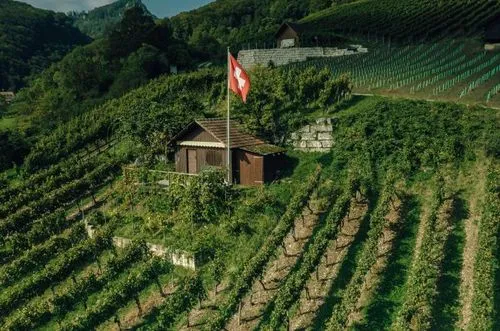Pinot Noir

Grape variety Red
Serving temperature:
13-15°C
Pinot Noir: a brief profile
Red grape variety
Area under vines in Switzerland: 3,758 hectares
Other names: Pinot Noir is also known as Blauburgunder or Spätburgunder, among others.
What Pinot Noir tastes like
Pinot Noir offers wines with aromas of red berries (strawberry, raspberry and cherry). Riper grapes offer aromas of wet leather, tobacco, autumn leaves and undergrowth. The wines are generally fresh and elegant.
A young Pinot Noir, aged 3 to 5 years, offers aromas of red fruits such as cherry and raspberry. This wine is characterised by mild acidity and soft tannins. By contrast, an older Pinot Noir (over 5 years old) presents more complex aromas. Often, this Pinot Noir is aged in oak barrels, which further develops its flavours, adding diversity and depth.
In general, Swiss Pinot Noir is characterised by its versatility. Depending on the growing region and terroir, the wine styles vary from light and fruity to powerful and complex premium wines.
Pinot Noir goes well with these dishes
Pinot Noir goes extremely well with salmon, duck and mushroom risotto due to its vibrant fruit flavours and delicate structure. A slightly chilled Pinot Noir harmonises well with Mediterranean dishes such as grilled vegetables or mature hard cheese. It is also recommended with dishes featuring pork, poultry and pasta with a creamy sauce.
History and cultivation of Pinot Noir
Pinot Noir plays an important role in Swiss viticulture: no other grape variety is as widespread. This originally French grape probably comes from Burgundy, where it was mentioned as early as 1375. In the canton of Vaud, Pinot Noir has been cultivated since the end of the 15th century, originally under the name Servagnin.
Pinot Noir is a demanding grape variety due to its susceptibility to various diseases and rot. It buds early in the year, which makes it vulnerable to frost.
It also has exacting requirements in terms of soil and location. It prefers calcareous clay soils, where it can ripen slowly and evenly.
Distribution of Pinot Noir in Switzerland
Pinot Noir is cultivated in all wine-growing regions of Switzerland today. The most important areas are German-speaking Switzerland, the Three-Lakes region and Valais.
Distribution of grape varieties
Pinot Noir is grown in several wine regions
36%
34%
13%
12%
4%
0%
FAQ: Frequently asked questions about the Pinot Noir grape variety
Pinot Noir is also known as Blauburgunder or Spätburgunder, among others.
The name "Pinot" comes from the French word for pine or pine cone, which is reminiscent of the shape of the grape.
To visit our site, you must be of legal drinking age in your country of residence.




